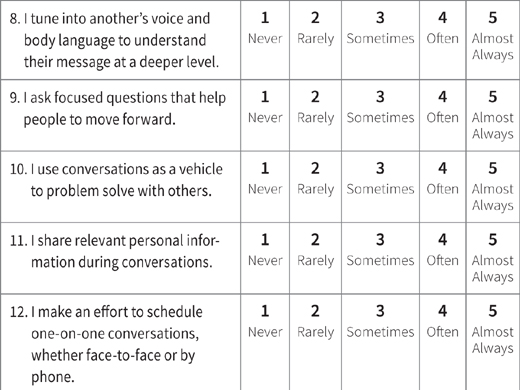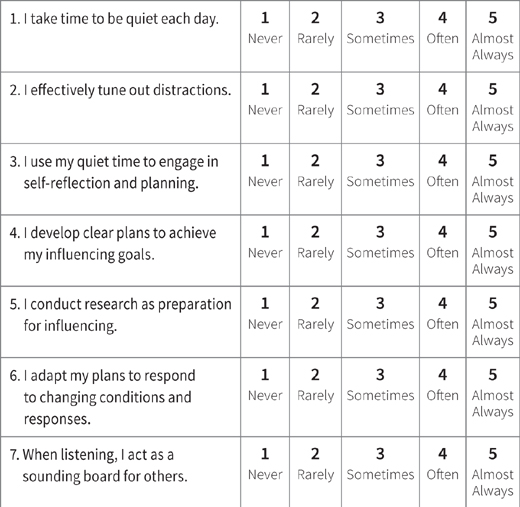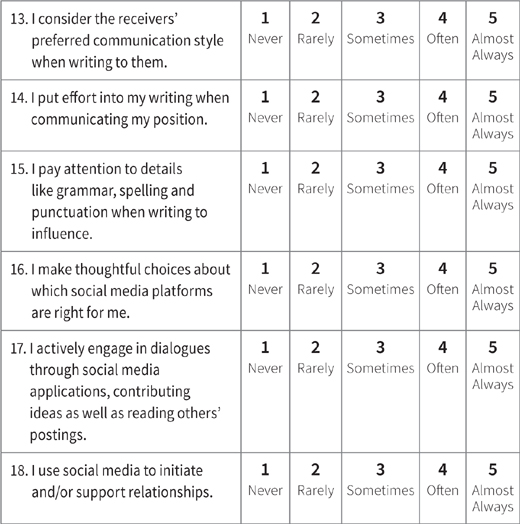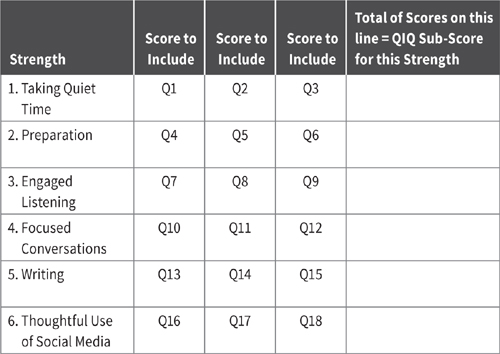Chapter 3
Your Quiet Influence Quotient (QIQ)
“What I want most to do is be influential.”
Philip Johnson, Architect
Would you like to know how well you perform as a Quiet Influencer? Start by taking this quiz to determine your Quiet Influence Quotient—your “QIQ.” This tool will let you know how effective you are at using each of the Six Strengths and give you a way to assess your progress as you apply the ideas in the book.
Based on actions that demonstrate the strengths that set Quiet Influencers apart, the QIQ will also give you an idea of how much you have in common with highly effective Quiet Influencers. Assess yourself by indicating how often you engage in these behaviors, using a scale from 1 (never) to 5 (almost always). A caution: Try not to overanalyze the questions. Your initial response is usually the most valid. Also avoid being too tough or easy a critic. Instead, when you respond, be as objective as possible.

How to Score and Interpret This Quiz
Total the numbers you circled. The following ranges reflect a rough estimate of your QIQ.
Caveat: This is not a scientific or “normed” instrument. Instead, it is a quick self-assessment tool that will help you see which of the strengths you use most often, which could use some development, and how you fare overall. Use it as a guide and starting point as you collect ideas from the book.
Consider yourself ... |
|
76–90 |
Very Strong You are using many of the strengths of highly effective Quiet Influencers. Take a look at how you can apply your strengths to some current or upcoming workplace challenges and situations. |
61–75 |
Solid You are doing well in demonstrating Quiet Influencing strengths. Some areas still could use some attention. Pinpoint the times when your influencing efforts are successful and not successful. See if you recognize any differences in your use of the Six Strengths in both situations. |
46–60 |
Moderate You have some work to do in ramping up your Quiet Influence strength portfolio. Pay attention to a work situation where you are not being effective and consider which different strengths you can apply that you don’t typically use. |
45 and below |
Lots of Room for Improvement You have some work to do in living up to your Quiet Influence potential. Start by noticing your own behavior and asking trusted co-workers for honest feedback and suggestions. Begin by working on one strength that you want to develop and set a specific goal for this week. Next week, tackle another skill. Keep at it, you will see results. |
Next take some time to compare how often you draw upon each individual strength to influence. Figure 3.1 identifies which questions correspond with which strengths. Add your responses related to each Quiet Influencing strength across the rows in Table 3.1. You may want to create a bar chart to compare the six subscores.
Use this guide to understand what each of the subscores mean:
If your sub-score on a strength is |
Consider youruse of this strength ... |
12–15 |
Very Strong You excel at this strength. Look for ways to apply it to your influencing challenges. Also think about how you can use it to feed other strengths that may not be as developed. |
10–11 |
Solid You are doing well in demonstrating this strength. Build on your success by applying it in a variety of new influencing opportunities. |
6–9 |
Moderate You have some work to do in developing this strength. Pinpoint the times when you use it with ease and see if you can identify what stops you from using it at other times. |
5 and below |
Lots of Room for Improvement Your low use of this strength is likely holding back your ability as a Quiet Influencer. Consider making it a top priority in your development plans. Watch and learn from effective Quiet Influencers around you who are comfortable using this strength. |
How to Use Your QIQ as
You Read Quiet Influence
Don’t be overwhelmed by the QIQ assessment—and certainly not by your score. It was your first self-assessment snapshot. You have barely gotten into the book yet! Just take it as a clue as to where to put your energies. Remember that you do not need to excel at all of the strengths, all of the time. Before you read chapters 4 through 9, take a look at the subscore in the QIQ Assessment that corresponds to the strength covered. If it’s very strong or solid, review the chapter with an eye to expanding the ways you already use this strength. Pay particular attention to the Overuse section to make sure that you’re not turning an overuse of a strength into a weakness.
If your subscore was moderate or showed lots of room for improvement, consider investing significant time on that chapter and the included advice and tips. Pay particular attention to those lower-scoring strengths that appear in your job description or that you know to be important in your job. For instance, if you are in sales, chances are that Engaged Listening and Focused Conversations are priority strengths for you. If the people you interact with are dispersed across a large corporation or all around the globe, the strengths of Writing and Thoughtful Use of Social Media will probably rank higher on your list.
No matter which strength or strengths you identify as your development priority, you’ll discover many useful ideas in this book, especially in chapters 4 through 9, where you will collect specific actions to act on today. These actions will enhance that strength. Regardless of which area you decide to address first, use the following additional tips to keep you moving towards an even higher QIQ:
Look for places to practice Once you have highlighted an influencing strength to work on, look for opportunities to apply that skill. Here’s an example: If you believe you may be missing out on voice and body language cues to understand peoples’ messages at a deeper level (question 8 on the quiz), consider your schedule and identify times when you might practice being more observant. The grocery store line, the gym, and walking to work all then become laboratories for observation and learning.
Give yourself a pat on the back After you try on a new approach, give yourself a big “atta boy or girl.” It’s always hard to go out of your comfort zone, and you should recognize yourself for taking that first step, even if it didn’t feel natural or have the desired consequences. Build on that feeling of accomplishment.
Recognize what is working Acknowledge when you have mastered a skill. Such recognition gives you a launching off point. Most likely, these higher rated strengths come more naturally to you. Keep using them to make an impact and remind yourself of those assets, especially those days when influencing feels like a chore.
Ask others for feedback You will accelerate your growth as a Quiet Influencer if you ask for and receive feedback from others who see you on a regular basis. Make it easy for people to help you improve by telling them what to look for. Let’s say you want to strengthen your writing. Consider asking a “QIQ buddy” to give you honest feedback on what was unclear in an email or proposal. You can only improve a skill when you know how you’re doing. Feedback will also reinforce your progress and build confidence.
Be aware of reactions Notice how you feel when you incorporate a new influencing strength. For instance, focused conversations may be uncomfortable at first if you usually influence people through writing. Be aware of the influencing results you are getting from your new behavior. Likewise, observe how others react. For instance, when you begin to initiate conversations, your co-workers might be surprised and maybe even a little wary. Usually, it takes only a little bit of time for everyone—including you—to adapt.
Your Next Steps
The advice in this book will be even more meaningful to you if you apply it to a specific influencing challenge you now face. Before going further, take some quiet time to reflect on the following questions and record your answers. I’ll be prompting you to think about this challenge as we go along.
1. Is there a situation at work in which you would like to have more influence? Take some time to describe it here.
2. Who is or are the key players involved?
3. What two or three main challenges do you face in this situation?
4. What actions or behaviors have you tried so far? What results have you seen?
5. What would be a satisfying outcome to this situation? How would things be different from how they are now?
6. Review your QIQ scores. Which one or two Quiet Influence strengths might you try applying to this influencing challenge?
No matter the level of challenge you face, in today’s workplace, Quiet Influence will increase the impact of your work, give you more deserved visibility, and bring high value to your organization. Your relationships will deepen. The investment you make in sharpening these strengths will have payoffs now and in the future.
But take it one step at a time. Let’s start where the Quiet Influence Process starts. It’s also where you are likely to enjoy your most thoughtful moments in the day or most idea-rich time of the week: during your quiet time.




